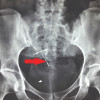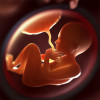
 IJCP Editorial Team
IJCP Editorial Team
A Retained Broken Suture Needle Retained During Cerclage Placement
Unintentional retention of broken suture needles is a rare event in obstetric procedures, particularly during pregnancy, and is rarely documented in literature.
A 36-year-old woman, who had been pregnant 12 times in the past and had had 5 previous deliveries, sought medical attention at 13 weeks of gestation for a history-indicated cerclage procedure. Incidentally, the suture needle broke during the cerclage, leaving a 35-mm fragment lodged in the cervical stroma between the 11 and 2 o'clock positions.
Despite multiple attempts, the needle fragment could not be retrieved, and the procedure proceeded without successful needle recovery. An intraoperative pelvic X-ray confirmed the presence of the retained fragment. No further attempts were made to retrieve the needle during the pregnancy, and a plan was established to remove it during the patient's subsequent cesarean delivery.
The patient went into labor at 32 1/7 weeks of gestation and underwent an uncomplicated cesarean delivery. The retained needle was then successfully removed through manual palpation of the fragment transvaginally.
The management of retained broken suture needles in obstetric procedures necessitates careful decision-making in pregnant patients, and the retention of a needle fragment until delivery may be considered if the risks associated with removal outweigh the expected benefits.
Source:Wodoslawsky S, Mossayebi MH, Alleyne G, Al-Kouatly HB. Obstetrics & Gynecology. 2023 Nov 1;142(5):1241-3.

IJCP Editorial Team
Comprising seasoned professionals and experts from the medical field, the IJCP editorial team is dedicated to delivering timely and accurate content and thriving to provide attention-grabbing information for the readers. What sets them apart are their diverse expertise, spanning academia, research, and clinical practice, and their dedication to upholding the highest standards of quality and integrity. With a wealth of experience and a commitment to excellence, the IJCP editorial team strives to provide valuable perspectives, the latest trends, and in-depth analyses across various medical domains, all in a way that keeps you interested and engaged.












Please login to comment on this article